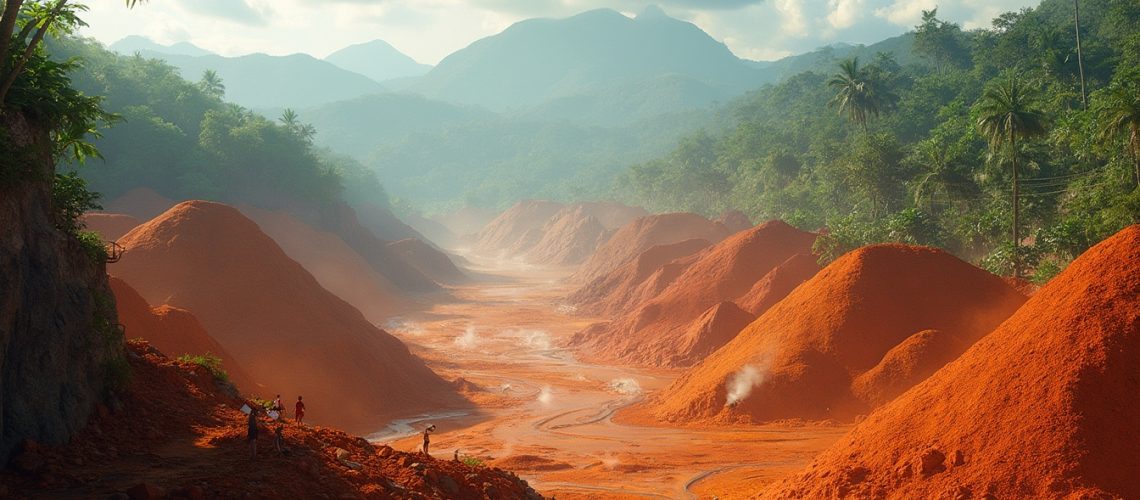Why Does the Panamanian President See No Environmental Threat from Copper at the Cobre Panama Mine?
The closure of the Cobre Panama mine has thrust Panama into the global spotlight, creating significant economic and environmental challenges. The mine, a critical asset for both First Quantum and Panama's national economy, represents a complex intersection of resource extraction, environmental management, and national regulatory frameworks.
Panamanian President José Raúl Mulino's assertion of no immediate environmental threat from the stockpiled copper has raised important questions about risk assessment and management in the mining sector. His statement comes at a critical moment when over 130,000 metric tons of copper concentrate remain stored at the site, following the Supreme Court's declaration nullifying First Quantum's operating contract.
The situation highlights the intricate balance between economic interests and environmental protection. With the mine accounting for nearly 5% of Panama's GDP, the stakes are extraordinarily high for both the national economy and international mining operations.
What Is the Current Status of the Cobre Panama Mine and Its Copper Reserves?
The Cobre Panama mine's current status represents a pivotal moment in Panama's mining history. In November, the nation's Supreme Court declared First Quantum's contract unconstitutional, effectively shutting down one of the world's largest copper production sites. This decision has created a complex scenario involving significant economic and environmental considerations.
The stockpile of 130,000 metric tons of copper concentrate presents both a challenge and an opportunity for Panama. Environmental Minister Juan Carlos Navarro's investigation has been critical in assessing potential risks associated with the stored materials. The government's approach demonstrates the growing importance of rigorous environmental assessment in resource extraction operations.
For investors interested in Investing in mining stocks, the Cobre Panama situation offers valuable insights into the regulatory risks facing international mining operations. The shutdown underscores the critical need for comprehensive compliance and engagement with local regulatory environments.
How Did the Panamanian Government Assess the Environmental Risk?
The Panamanian government's environmental risk assessment represents a sophisticated approach to resource management. Environmental Minister Juan Carlos Navarro led an investigation that conducted a comprehensive site inspection approximately one month prior to the current discussions, finding no immediate hazardous risks.
Technical considerations played a crucial role in the assessment. Experts examined potential chemical reactions that could lead to elevated temperatures and hazardous gas emissions during prolonged copper concentrate storage. First Quantum had previously warned about the risks of extended storage, highlighting the complexity of managing large mineral stockpiles.
The investigation methodology showcased the importance of Digital transformation in mining technologies in risk assessment. Advanced monitoring systems enabled precise evaluation of potential environmental threats, demonstrating the evolving nature of environmental management in resource extraction.
What Are the Next Steps for Managing the Copper Stockpile?
The Panamanian government faces a complex decision-making process regarding the copper stockpile. President Mulino has clearly stated the national priority: "If it has to be taken out, it has to be, but there also has to be payment to us, Panama." This stance emphasizes the economic considerations alongside environmental management.
Negotiations will focus on several critical aspects, including payment arrangements and export strategies. The copper concentrate legally belongs to Panama following the contract nullification, creating a unique challenge for both the government and First Quantum. Local fishing boat protests blocking the mine's pier further complicate potential export plans.
The January decision will be pivotal in determining the future of the copper stockpile. Investors tracking Uranium mining investment strategies will find parallels in the complex regulatory environments facing resource extraction companies.
How Does the Mine's Closure Impact Panama's Economy and First Quantum?
The economic implications of the Cobre Panama mine closure are profound. The mine previously contributed approximately 40% of First Quantum's revenue and represented nearly 5% of Panama's GDP. This sudden disruption creates significant challenges for both the company and the national economy.
First Quantum must now navigate a complex landscape of legal and economic uncertainties. The company's global operations will likely feel the impact of this unexpected closure, potentially influencing investor confidence and future investment strategies in resource-rich regions.
For Panama, the economic ripple effects extend beyond immediate revenue loss. The closure highlights the delicate balance between environmental protection and economic development, a challenge faced by many resource-rich nations.
Why Is Cobre Panama an Environmental and Economic Focal Point Globally?
The Cobre Panama mine represents a critical case study in the global copper market and green energy transitions. Copper remains a fundamental mineral in renewable energy technologies, making this shutdown particularly significant for global supply chains.
Global commodity markets are closely watching the situation, recognizing the potential implications for copper supply and pricing. The incident underscores the increasing importance of environmental considerations in resource extraction, a trend that extends beyond Panama's borders.
Investors tracking Gold ETFs investment strategies will find valuable insights in the Cobre Panama case, which demonstrates the complex interplay between environmental regulations, national interests, and global resource markets.
What Are the Broader Environmental and Industry Implications?
The Cobre Panama mine closure represents more than a single operational challenge. It symbolizes the broader global debate surrounding sustainable resource extraction, environmental protection, and national economic interests.
International mining companies must now carefully consider the evolving regulatory landscapes in resource-rich countries. The incident highlights the growing importance of comprehensive environmental assessments, community engagement, and adaptive management strategies.
The global mining industry stands at a critical juncture, where environmental considerations are becoming as important as economic outcomes. The Cobre Panama case will likely influence future discussions about responsible resource extraction and international mining operations.
Want to Stay Ahead in Mineral Investing?
Discover valuable opportunities with Discovery Alert's fast, AI-driven notifications, providing real-time insights into significant ASX mineral discoveries. Perfect for both new and seasoned investors, our service simplifies complex announcements and identifies actionable opportunities, including both short-term trades and major discoveries. Experience these advantages with a 30-day free trial by visiting Discovery Alert today.







